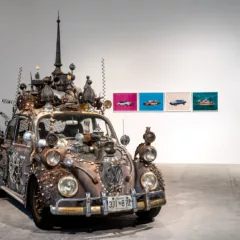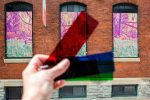Two days before tonight’s opening, folk artist/gay activist Ralfka Gonzalez was sitting in the middle of A Seed on Diamond slipping final touches on to a painting. He was a little apologetic of as he reinterpreted the virgin’s traditional gold fleur de lis into runic gestures.
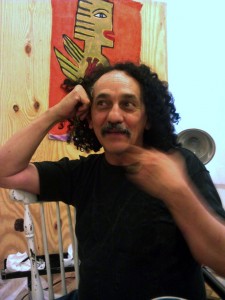
Like Ralfka, the show is exuberant. It has two titles. No kidding. I hardly know which one to use. There’s Idiots, Icons & Idols: Ralfka Gonzalez; and then there’s Ralfka Gonzalez: That was then, this is now. Either way, the colors, the little devils, snakes and holy virgins–all burst from the canvases, sometimes with phrases thrown in. Good news. There’s a raffle on opening night. Throw in a small investment and you may get something bigger back if one of those little devils gives you some luck! The opening is tonight (Sat., Sept. 10, 6-10pm).
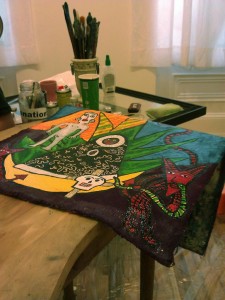
Gonzalez, a San Antonio native, used to live in Philadelphia–he “followed love here”–and while here the self-taught artist was in a number of exhibits, including at PAFA, Nexus and the African American History Museum. The Pennsylvania Convention Center sports one of his murals, El Gran Conjunto del Fin del Mundo, and Indigo Gallery has been carrying his work for 30 years, he said. A project with Taller Puertorriqueño and Pew sent him to the Mission Cultural Center in San Francisco, and he left Philadelphia behind for good. From there it was just a short jump south to Oaxaca–because someone told him his art work looked pretty Oaxacan!
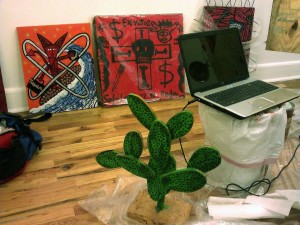
We talked a little about his life, the well-springs of his painting, and the culture he has adopted as his own in Oaxaca, where he spends half the year. A cheerful person, every once in a while tears spring to his eyes as he remembers his own brush with death, and the people he has lost. The discussion is more of a conversation than an interview, with Ralfka circling back over and over to the things that he cares about and worries about most.
He said an NEA grant in ’89 allowed him to spend the summer in Oaxaca, and since then he has cycled to San Francisco, Oaxaca and back again. In San Francisco, he shares a tiny studio, but in Oaxaca, his studio is spacious.
“I have a really good gallery there, La Mano Magica” (website not working).
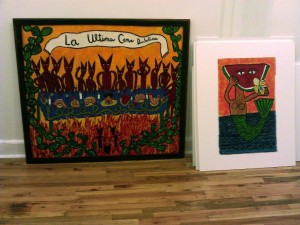
Can you tell me about the imagery in your work, like the cute little devils?
“They are fools and jesters–our own folly and a celebration of life. They are testers, to make you stronger. In mexico they do devil dances–on Nov. 1. …The snakes with virgins are good over ego, discipline over what you can’t control.”
Later he said, “I designed the first sexually explicit safe-sex poster in Oaxaca–explicit with the little devils in it.”
Is your family background Mexican?
“Yes, I am totally Mexican. My family is from Northern Mexico.” In San Antonio, his father worked for United Fruit. “They called him the banana king.” Banana logos also show up in Ralfka’s paintings.
“I have HIV now. Like Tina Turner I got away and left all my stuff.” And within five months, I had full-blown AIDS. Sept. 10 is the day I learned I had it. I saw Nina Simone the night I found out, and I just cried the whole concert.” That was 10 years ago, the day before the planes flew into the World Trade Center.
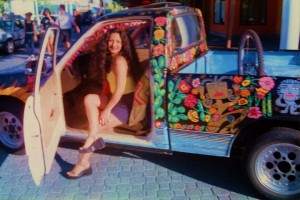
After Sept. 11, people started leaving notes on his painted car, notes like “art heals,” from people who didn’t know anything about him or what he was going through. “I didn’t realize the power of what goes through me–that art had a lot of power. Painting is like a prayer.
“I kept painting on my car. The doctor said I would live! …I felt so blessed, going from full blown AIDS to HIV. I realized my self-taught imagery had an impact.”
The World Trade Center had particular meaning for him. Before all this happened to him, he used to go to the top there “to make affirmations–about having a children’s book, which happened; about showing my art work more, which happened.”
When did you start painting?
“I started painting when my mother died. I painted on bed sheets with house paint. I had the house to myself. Within a few months, my father had a major heart attack. I was depressed in San Antonio.”
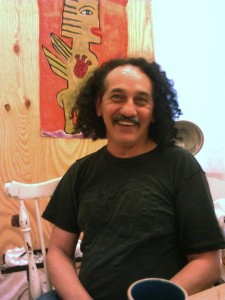
The first thing he painted was what he calls The Ba Man, a winged angel, that appears over and over in his paintings. But he first got the name from the punk-rock band Ba Syndicate. He himself was a punk rocker. Later he discovered Ba was the soul in Egyptian mythology. While he feels he is someone who has been called to paint because that is his destiny, he also comes from a family craft tradition.
“It’s not academic. It’s something I have to do. It was clear to me. I was close to death, and seeing how strangers responded to those colors…”
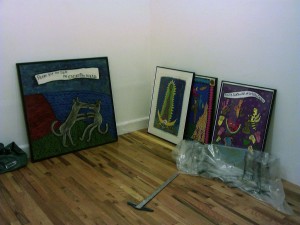
Why are you raffling off a painting?
“It’s very expensive to put on an art show. This can of paint cost $11. I’m on disability. I spend a lot of money on art supplies. When I am putting on an art show, I spend a lot more money than I make. They (Seed of Diamond) flew me here, they paid for the shipping. I want to pay them back.”
How has being ill affected your life?
“Being ill is like a filter. My hair is like a filter. Since 2001 I’ve grown my hair out. People make assumptions based on [my HIV and how my hair looks]. A guy I worked with in catering…, he had Tourettes. He said to me, ‘I love my Tourettes. If anybody gives me shit about my Tourettes, I know I don’t have to deal with them. It’s a filter from those who are prejudiced.’ That’s how I feel about my hair; that’s how I feel about my AIDS.
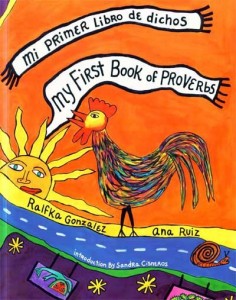
“I lost so many people to AIDS. I’ve lost 40 friends, three or four really close friends, in San Antonio [where they assumed that AIDS was just in San Francisco or in New York, and so they didn’t take precautions]. That was my Vietnam War.
“In Oaxaca every family has to have a drag queen. They are the shamans. If there’s a feminine boy, he starts getting raised as a girl and taught Oaxacan witchcraft. I want to be a tour guide there.”
But he doesn’t want people to look on the drag queens or muxes, which came out of the indiginous culture there, as freaks or side shows. “I could let people know they can…survive.”



